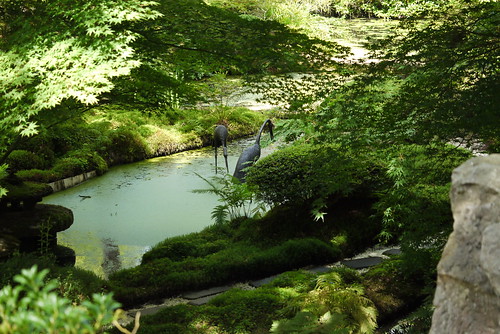The Japanese Garden is thought to be the result of of Alan de Tatton’s visit to the Anglo-Japanese Exhibition at the White City in London in 1910:
Inspired by what he saw there, Alan de Tatton decided to introduce a Japanese garden to Tatton. A team of Japanese workmen arrived to put together what is now rated to be the “finest example of a Japanese Garden in Europe.”
The Shinto Shrine and artefacts contained within the garden are all reputed to have been brought from Japan especially for the construction of the garden.
The garden itself is in the style of the tea garden which does not reflect the strict discipline of other Japanese styles, e.g. the dry garden or the stroll garden. In this form of art, the Japanese portray many scenes, both mythical and factual, but all must harmonise with nature. The important elements of plants, stones and rocks are carefully placed to produce a natural balance.
Stones and rocks are selected for their form, particularly their representative shape. It is not unusual for a mound to be built capped off with white stones representing the sacred snow-capped Mount Fuji, the most important mountain in Japan. Lanterns come in all shapes and sizes having different functions such as the specially shaped snow viewing lanterns, designed to trap as much snow as possible on the top of the lantern to add to the beauty of the garden in Winter.
Flowers as such are not given as much consideration, however tree shapes are of great importance and as a result pruning techniques are critical and take many years to develop. This garden uses many Japanese Maples or Acers which you would not always find in the true Japanese gardens. Attention is always paid to the form and shape of the plants as can be seen from the Bamboo at the west end of the garden. Many evergreen plants are also included here which add to the winter interest.
The garden was restored in 2000/2001 for the Japan Festival and was the result of over 14 years of research with input from various Japanese specialists. The project restored the garden to its original state when first created for the Egerton family in Japanese ‘style’ with a heavy western influence.*
*Information from the Tatton Garden website.











Wow. Your photos are truly gorgeous. What an incredible garden.
Thanks Annie, it is quite special
That is such a beautiful garden Cherie
It is Jams
Cherie, I have been a visitor to your blog for some time. You have showed me places I will never see as I am an armchair traveler. I always learn history and more, I love the many flowers you photograph. The trip to the Japanese garden was special as we have one at our botanical garden in Alabama. Thank you for all your posts.
Thanks for your kind comments, I am glad you have been enjoying the posts and photographs
It is a really lovely garden. I have a friend who used to live in Japan and who enjoys explaining the symbolism of Japanese gardens.
What a gorgeous place.
Isn’t it just
Amazing how that was originally turned into an artform and it appears in Britain.
Some of the gardens are quite fascinating especially when the symbolism is explained.
Monet sprung to mind! Awesome and here in UK too. Great stuff. Dxx
It does look rather like Monet doesn’t it. I should run it through one of my photo-painting programmes to give it those Monet colours.
Monet would love this garden.
NT should consider to paint this bridge red.
What have you been up to lately?
Just got back from Singapore few days ago.
Saw tons of tropical flowers there.
So exotic and colourful!
I hope you had a great time on your holidays. I am looking forward to seeing all the photos
I haven’t been to this one ( I don’t think) But, love this garden, it does look like a great place to sit and have a splodge with paints.
It would be a great place to sit and paint